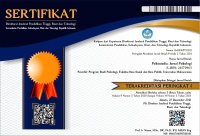Employability Predictor Factors : Resilience, Self-Esteem, and Self-Confidence
Abstract
This purpose of this study is to empirically examine the relationship between resilience, self-esteem, and self-confidence with employability. The researcher used class XI and XII students of private vocational schools in Kutawaluya as research subjects. The criteria that researchers set are students who have completed the industrial work practice program. The research sample consisted of 78 students of class XI and XII Business and Motorcycle Engineering, XI and XII Office Automation and Governance. Researchers obtained it by means of cluster random sampling technique. The measurement instrument that the researcher uses is the Likert model scale (employability scale, resilience scale, self-esteem scale, self-confidence scale) which the researcher compiled himself. The data analysis that the researcher uses is multiple linear regression with the SPSS V26 program. The results of the analysis show that simultaneously there is a very significant relationship between resilience, self-esteem, and self-confidence with employability (R = 0.884 and Sig. = 0.000). Based on these results, it can be concluded that the variables of resilience, self-esteem, and self-confidence can be predictors of high and low employability , so that the higher the resilience, self-esteem, and self-confidence of students, the higher the level of employability they have.
Penelitian ini bertujuan untuk menguji secara empiris hubungan antara resiliensi, harga diri, dan kepercayaan diri dengan employability. Peneliti menggunakan siswa kelas XI dan XII SMK Swasta yang ada di Kutawaluya sebagai subjek penelitian. Kriteria yang peneliti tetapkan yaitu siswa-siswa yang telah menyelesaikan program praktek kerja industri. Sampel penelitian berjumlah 78 yang terdiri dari siswa kelas XI TBSM, XI OTKP, XII TBSM dan XII OTKP. Peneliti memperolehnya dengan cara teknik cluster random sampling. Instrumen pengukuran yang peneliti gunakan adalah skala model likert (skala employability, skala resiliensi, skala harga diri, skala kepercayaan diri) yang peneliti susun sendiri. Analisis data yang peneliti gunakan adalah regresi linier berganda dengan program SPSS V26. Hasil dari analisis menunjukkan bahwa secara simultan ada hubungan yang sangat signifikan antara resiliensi, harga diri, dan kepercayaan diri dengan employability (R = 0,884 dan Sig. = 0,000). Berdasarkan hasil tersebut dapat disimpulkan bahwa variabel resiliensi, harga diri, dan kepercayaan diri mampu menjadi prediktor dari tinggi rendahnya employability, sehingga semakin tinggi resiliensi, harga diri, dan kepercayaan diri siswa maka semakin tinggi juga tingkat employability yang dimilikinya.
Keywords
Full Text:
FULL TEXTReferences
Akbari, O., & Sahibzada, J. (2020). Students’ self-confidence and its impacts on their learning process. American International Journal of Social Science Research, 5(1), 1–15. https://doi.org/10.46281/aijssr.v5i1.462
Beaumont, E., Gedye, S., & Richardson, S. (2016). ‘Am I employable?’: Understanding students’ employability confidence and their perceived barriers to gaining employment. Journal of Hospitality, Leisure, Sport & Tourism Education, 19, 1–9. https://doi.org/10.1016/j.jhlste.2016.06.001
Behroozi, M. (2014). A survey about the function of technical and vocational education: An empirical study in Bushehr City. Procedia - Social and Behavioral Sciences, 143, 265–269. https://doi.org/10.1016/j.sbspro.2014.07.401
BPS. (2019). Agustus 2019: Tingkat Pengangguran Terbuka (TPT) sebesar 5,28 persen. Badan Pusat Statistik.
Brewer, L. (2013). Enhancing youth employability: What? Why? And How? Guide to core work skills. International Labour Organization.
Connor, K. M., & Davidson, J. R. T. (2003). Development of a new resilience scale: The Connor-Davidson Resilience Scale (CD-RISC). Depression and Anxiety, 18(2), 76–82. https://doi.org/10.1002/da.10113
Coopersmith, S. (1967). The antecedents of self-esteem. W. H. Freeman.
Dacre Pool, L., & Sewell, P. (2007). The key to employability: Developing a practical model of graduate employability. Education + Training, 49(4), 277–289. https://doi.org/10.1108/00400910710754435
Dehmer, J. J., Amos, K. D., Farrell, T. M., Meyer, A. A., Newton, W. P., & Meyers, M. O. (2013). Competence and confidence with basic procedural skills: The experience and opinions of fourth-year medical students at a single institution. Academic Medicine, 88(5), 682–687. https://doi.org/10.1097/ACM.0b013e31828b0007
Eraydın, Ş., & Karagözoğlu, Ş. (2017). Investigation of self-compassion, self-confidence and submissive behaviors of nursing students studying in different curriculums. Nurse Education Today, 54, 44–50. https://doi.org/10.1016/j.nedt.2017.03.007
Finch, D. J., Hamilton, L. K., Baldwin, R., & Zehner, M. (2013). An exploratory study of factors affecting undergraduate employability. Education + Training, 55(7), 681–704. https://doi.org/10.1108/ET-07-2012-0077
Fugate, M., Kinicki, A. J., & Ashforth, B. E. (2004). Employability: A Psycho-social construct, its dimensions, and applications. Journal of Vocational Behavior, 65(1), 14–38. https://doi.org/10.1016/j.jvb.2003.10.005
Ganesan, G., & Muthukrishnan, A. K. (2015). Employability Skill: A Literature Review. International Journal of Advance Research in Computer Science and Management Studies, 3(3), 353–360.
Khairunnisa, D., Widiana, H. S., & Suyono, H. (2022). Kepercayaan diri dan psychological well-being terhadap employability pada siswa SMK. Psikostudia: Jurnal Psikologi, 11(1), 13–21. https://doi.org/10.30872/psikostudia
Krueger, J. I., & Heck, P. R. (2021). The end of overconfidence. The American Journal of Psychology, 134(1), 114–119. https://doi.org/10.5406/amerjpsyc.134.1.0114
Lauster, P. (2005). Tes kepribadian. Bumi Aksara.
Magrin, M., Marini, E., & Nicolotti, M. (2019). Employability of disabled graduates: Resources for a sustainable employment. Sustainability, 11(6), 1542. https://doi.org/10.3390/su11061542
Orth, U., & Robins, R. W. (2014). The development of self-esteem. Current Directions in Psychological Science, 23(5), 381–387. https://doi.org/10.1177/0963721414547414
Orth, U., Robins, R. W., & Widaman, K. F. (2012). Life-span development of self-esteem and its effects on important life outcomes. Journal of Personality and Social Psychology, 102(6), 1271–1288. https://doi.org/10.1037/a0025558
Perkins, K. E. (2018). The integrated model of self-confidence: Defining and operationalizing self-confidence in organizational settings [Dissertation]. Florida Institute of Technology.
Potgieter, I. (2012). The relationship between the self-esteem and employability attributes of postgraduate business management students. SA Journal of Human Resource Management, 13(1), 1–15. https://doi.org/10.4102/sajhrm.v10i2.419
Pulford, B. D., Woodward, B., & Taylor, E. (2018). Do social comparisons in academic settings relate to gender and academic self-confidence?. Social Psychology of Education, 21(3), 677–690. https://doi.org/10.1007/s11218-018-9434-1
Rojas, L. F. (2015). Factors affecting academic resilience in middle school students: A case study. GiST Education and Learning Research Journal, 11, 63–78. https://doi.org/10.26817/16925777.286
Ronnås, P., & Shamchiyeva, L. (2011). Employment diagnostic analysis: Maluku, Indonesia. ILO.
Rosenberg, M. (1965). Society and the adolescent self-image. Princeton University Press. https://doi.org/10.1515/9781400876136
Semeijn, J. H., Caniëls, M. C. J., & Kooistra, D. (2019). Cross-lagged effects of resilience and indicators of sustainable employability a study among dutch police officers. Policing: An International Journal, 42(6), 961–975. https://doi.org/10.1108/PIJPSM-01-2019-0003
Tentama, F., & Abdillah, M. H. (2019). Student employability examined from academic achievement and self-concept. International Journal of Evaluation and Research in Education, 8(2), 243-248. https://doi.org/10.11591/ijere.v8i2.18128
UIS. (2012). International standard classification of education: ISCED 2011. UNESCO Institute for Statistics. http://www.uis.unesco.org/Education/Documents/isced-2011-en.pdf
van de Werfhorst, H. G. (2011). Skill and education effects on earnings in 18 Countries: The role of national educational institutions. Social Science Research, 40(4), 1078–1090. https://doi.org/10.1016/j.ssresearch.2011.03.004
Yorke, M. (2006). Learning & employability. Dalam Employability in higher education: What it is – what it is not. The Higher Education Academy.
DOI: http://dx.doi.org/10.30872/psikostudia.v11i2.7357
Refbacks
- There are currently no refbacks.
Copyright (c) 2022 Psikostudia : Jurnal Psikologi

This work is licensed under a Creative Commons Attribution-ShareAlike 4.0 International License.
Indexing by :
_________________________________________
PSIKOSTUDIA: Jurnal Psikologi Published by Faculty of Social and Political Siences, University of Mulawarman, Samarinda, East Kalimantan and This work is licensed under a Creative Commons Attribution-ShareAlike 4.0 International License.
_________________________________________
PSIKOSTUDIA: Jurnal Psikologi
Department of Psychology
Faculty of Social and Political Siences, University of Mulawarman
Jl. Muara Muntai Kampus Gn. Kelua Samarinda 75411
Phone: +62 813 35350368
E-Mail: psikostudia@fisip.unmul.ac.id




















